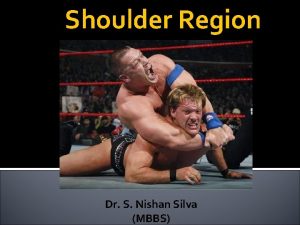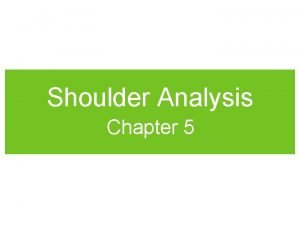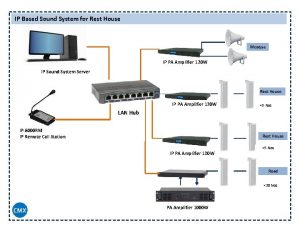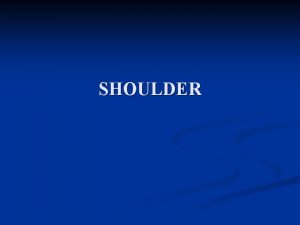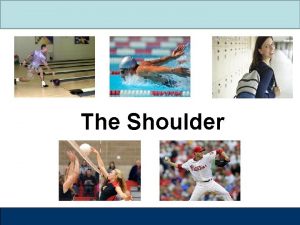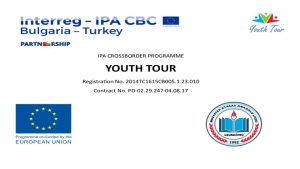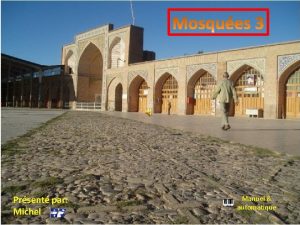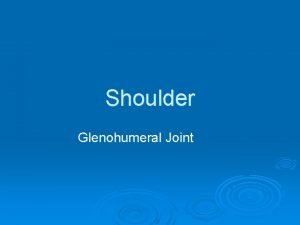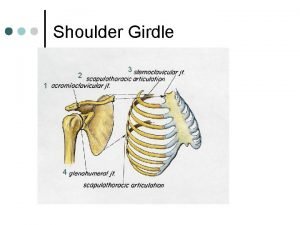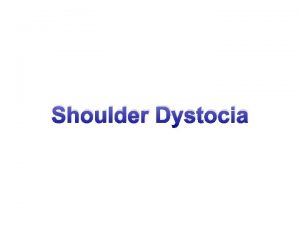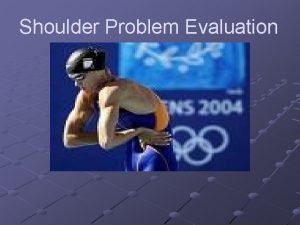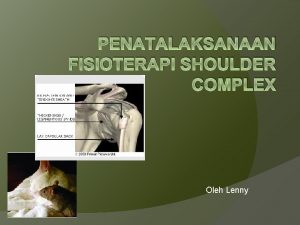In the name of GOD Sheikhlotfolah mosque Shoulder




















































- Slides: 52

In the name of GOD Sheikhlotfolah mosque

Shoulder &Upper arm Physical Examination Babak Vahdatpour MD Associate professor Department of Physical Medicine & Rehab. Isfahan University of Medical Sciences






DDx. of Shoulder Pain or reduced R. O. M • • • Rotator Cuff Dis. Adhesive Capsulitis Calcific Tendonitis Dynamic Functional Instability A. C Degenerative Joint Dis. Glenohumeral Degenerative Joint Dis. Arthropathy(crystalline & Rheumatoid) Cervical Radiculopathy Tumors(shoulder girdle & lung apex)

Physical Examination • • • inspection palpation range of motion Strength, sensation provocative shoulder test neck & elbow

Inspection • • both shoulders exposed inspection of both shoulders swelling asymmetry muscle atrophy scars ecchymosis venous distension

Inspection • squaring of the shoulder → anterior dislocation Swollen subacromial bursa in R. A Rupture of the left pectoralis major tendon.

Inspection Fractured left clavicle. Swollen sternoclavicular joint due to a fracture of the medial end of the left clavicle

• scapular "winging" → shoulder instability serratus anterior dysfunction trapezius dysfunction • Rupture of the long head of the biceps tendon (arrow).

Inspection • atrophy of the supraspinatus or infraspinatus → rotator cuff tear suprascapular nerve entrapment neuropathy

Palpation • tenderness • deformity

1. subacromial space → rotator cuff tendinitis impingement syndrome calcific tendinitis rotator cuff tear 2. bicipital groove → bicipital tendinitis bicipital tendon subluxation, tear 3. acromioclavicular joint 4. anterior glenohumeral joint → glenohumoral arthritis osteonecrosis glenoid labrum tear adhesive capsulitis 5. sternoclavicular joint

6. posterior edge of acromion → rotator cuff tendinitis calcific tendinitis rotator cuff tear 7. suprascapular notch → suprascapular nerve entrapment 8. Quadrilateral space → axillary nerve entrapment


Range of Motion testing • compared with the unaffected side • active & passive : loss of active motion alone → weakness of muscle than joint ds : LOM with both active & passive Ex → arthropathies adhesive capsulitis

Range of Motion testing • Flextion & Extension • Abduction & Adduction (scapulohumeral rhythm) • Internal rotation & External rotation • Scapular Retraction & Protraction

Apley scratch test


Painful arc of abduction. Passive shoulder abduction

Shrugging of the scapula to increase abduction (right shoulder)


Measurement of rotation in 90° abduction. A, Neutral position. B, External rotation. C, Internal rotation.


Muscle testing • • • Scapular stabilizers Rotator cuff Humeral Adductor/Internal Rotators Humeral Abductors Elbow Flexors & Extensors

Scapular stabilizers – Serratus ant. – Rhomboids – Trapezius

Evaluating the Rotator cuff • supraspinatus infraspinatus teres minor subscapularis • pain • weakness

Supraspinatus • "empty can" test (Jobe test) FIGURE 3. Supraspinatus examination ("empty can" test). The patient attempts to elevate the arms against resistance while the elbows are extended, the arms are abducted and the thumbs are pointing downward.

Infraspinatus and Teres minor FIGURE 4. Infraspinatus/teres minor examination. The patient attempts to externally rotate the arms against resistance while the arms are at the sides and the elbows are flexed to 90 degrees

Subscapularis & other int. rotators

Humeral Adductor/Internal Rotators • Pecturalis Major • Latissimus Dorsi

Humeral Abductors • Deltoid • Supraspinatous

Sensory Exam

Elbow Flexors & Extensors • • Biceps Brachialis Brachioradialis Triceps

Provocative test

Neer's test(sign) • subacromial impingement • impingement test : injection FIGURE 5. Neer's test for impingement of the rotator cuff tendons under the coracoacromial arch. The arm is fully pronated and placed in forced flexion.

Hawkin's test • subacromial impingement • rotator cuff tendonitis FIGURE 6. Hawkins' test for subacromial impingement or rotator cuff tendonitis. The arm is forward elevated to 90 degrees, then forcibly internally rotated.

Drop-arm test • rotator cuff tear • supraspinatus dysfunction

O`Brien test A. C joint or labrum injury

Cross-chest test • acromioclavicular joint dysfunction FIGURE 7. Cross-arm test for acromioclavicular joint disorder. The patient elevates the affected arm to 90 degrees, then actively adducts it.

Ant. Apprehension • ant. instability FIGURE 8. Apprehension test for anterior instability. The patient's arm is abducted to 90 degrees while the examiner externally rotates the arm and applies anterior pressure to the humerus.

Relocation & Release test

Jerk test & post. Apprehension test • Post. instability

Sulcus sign • inferior glenohumeral instability FIGURE 10. Sulcus test for glenohumeral instability. Downward traction is applied to the humerus, and the examiner watches for a depression lateral or inferior to the acromion.

Speed's maneuver • proximal tendon of the long head of the biceps

Yergason test • biceps tendon FIGURE 9. Yergason test for biceps tendon instability or tendonitis. The patient's elbow is flexed to 90 degrees, and the examiner resists the patient's active attempts to supinate the arm and flex the elbow.

Thoracic Outlet Syndrome • Adson`s test

Thoracic Outlet Syndrome • Roos` test

33 pole Isfahan
 Shoulder impringement
Shoulder impringement Shoulder muscle name
Shoulder muscle name Name all the lines
Name all the lines Alma road mosque
Alma road mosque Zion mosque
Zion mosque Mosque of selim ii khan academy
Mosque of selim ii khan academy Grand mosque seizure
Grand mosque seizure Hammamet with its mosque
Hammamet with its mosque Bakit yumaman ang mga imperyong ghana, mali at songhai
Bakit yumaman ang mga imperyong ghana, mali at songhai Baitul hameed mosque
Baitul hameed mosque Faisal mosque
Faisal mosque Yavuz sultan selim mosque
Yavuz sultan selim mosque Mosque audio system
Mosque audio system Prophet's mosque
Prophet's mosque Holy cribs mosque
Holy cribs mosque Karte sakhi mosque
Karte sakhi mosque Parts of the mosque
Parts of the mosque Hát kết hợp bộ gõ cơ thể
Hát kết hợp bộ gõ cơ thể Ng-html
Ng-html Bổ thể
Bổ thể Tỉ lệ cơ thể trẻ em
Tỉ lệ cơ thể trẻ em Chó sói
Chó sói Glasgow thang điểm
Glasgow thang điểm Hát lên người ơi alleluia
Hát lên người ơi alleluia Các môn thể thao bắt đầu bằng tiếng bóng
Các môn thể thao bắt đầu bằng tiếng bóng Thế nào là hệ số cao nhất
Thế nào là hệ số cao nhất Các châu lục và đại dương trên thế giới
Các châu lục và đại dương trên thế giới Công của trọng lực
Công của trọng lực Trời xanh đây là của chúng ta thể thơ
Trời xanh đây là của chúng ta thể thơ Mật thư anh em như thể tay chân
Mật thư anh em như thể tay chân Phép trừ bù
Phép trừ bù độ dài liên kết
độ dài liên kết Các châu lục và đại dương trên thế giới
Các châu lục và đại dương trên thế giới Thơ thất ngôn tứ tuyệt đường luật
Thơ thất ngôn tứ tuyệt đường luật Quá trình desamine hóa có thể tạo ra
Quá trình desamine hóa có thể tạo ra Một số thể thơ truyền thống
Một số thể thơ truyền thống Cái miệng nó xinh thế
Cái miệng nó xinh thế Vẽ hình chiếu vuông góc của vật thể sau
Vẽ hình chiếu vuông góc của vật thể sau Biện pháp chống mỏi cơ
Biện pháp chống mỏi cơ đặc điểm cơ thể của người tối cổ
đặc điểm cơ thể của người tối cổ Ví dụ về giọng cùng tên
Ví dụ về giọng cùng tên Vẽ hình chiếu đứng bằng cạnh của vật thể
Vẽ hình chiếu đứng bằng cạnh của vật thể Phối cảnh
Phối cảnh Thẻ vin
Thẻ vin đại từ thay thế
đại từ thay thế điện thế nghỉ
điện thế nghỉ Tư thế ngồi viết
Tư thế ngồi viết Diễn thế sinh thái là
Diễn thế sinh thái là Dot
Dot Số nguyên tố là
Số nguyên tố là Tư thế ngồi viết
Tư thế ngồi viết Lời thề hippocrates
Lời thề hippocrates Thiếu nhi thế giới liên hoan
Thiếu nhi thế giới liên hoan
